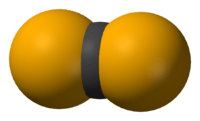Carbon diselenide
| | |
| | |
 | |
| Names | |
|---|---|
| Other names
Carbon selenide, diselenoxomethane, methanediselone | |
| Identifiers | |
| 506-80-9 | |
| 3D model (Jmol) | Interactive image |
| ChemSpider | 61481 |
| ECHA InfoCard | 100.007.323 |
| PubChem | 68174 |
| |
| |
| Properties | |
| CSe2 | |
| Molar mass | 169.93 g/mol |
| Appearance | yellow liquid |
| Density | 2.6824 g/cm3 |
| Melting point | −43.7 °C (−46.7 °F; 229.5 K) |
| Boiling point | 125.5 °C (257.9 °F; 398.6 K) |
| 0.054 g/100 mL | |
| Solubility | soluble in CS2, toluene |
| 0 D | |
| Thermochemistry | |
| 5032 J/mol K | |
| Std molar entropy (S |
263.2 J/mol K |
| Std enthalpy of formation (ΔfH |
219.2 kJ/mol |
| Hazards | |
| Flash point | 30 °C (86 °F; 303 K) |
| Except where otherwise noted, data are given for materials in their standard state (at 25 °C [77 °F], 100 kPa). | |
| | |
| Infobox references | |
Carbon diselenide is an inorganic compound with the chemical formula CSe2. It is a yellow-orange oily liquid with pungent odor. It is an analogue of carbon disulfide (CS2). This light-sensitive compound is insoluble in water and soluble in organic solvents.
Synthesis, structure and reactions
Carbon diselenide is a linear molecule with D∞h symmetry. It is produced by reacting selenium powder with dichloromethane vapor near 550 °C.[1]
- 2 Se + CH2Cl2 → CSe2 + 2 HCl
It was first reported by Grimm and Metzger, who prepared it by treating hydrogen selenide with carbon tetrachloride in a hot tube.[2]
Like carbon disulfide, carbon diselenide polymerizes under high pressure. The structure of the polymer is thought to be a head-to-head structure with a backbone in the form of –[Se–C(=Se)–C(=Se)–Se]–.[3] The polymer is a semiconductor with a room-temperature conductivity of 50 S/cm.
In addition, carbon diselenide is a precursor to tetraselenafulvalenes,[4] the selenium analogue of tetrathiafulvalene, which can be further used to synthesize organic conductors and organic superconductors.
Carbon diselenide reacts with secondary amines to give dialkydiselenocarbamates:[1]
- 2 Et2NH + CSe2 → (Et2NH2+)(Et2NCSe2−)
Safety
Carbon diselenide has high vapor pressure. It has a moderate toxicity and presents an inhalation hazard. It may be dangerous due to its easy membrane transport. It decomposes slowly in storage (about 1% per month at –30 °C). When obtained commercially, its cost is high.[5]
Mixed with air, carbon diselenide releases an extremely offensive odor.[6] Its smell forced an evacuation of a nearby village when it was first synthesized in 1936. The stench can be neutralized by oxidizing with bleach.[7] Because of the odor, synthetic pathways have been developed to avoid its use.[8]
References
- 1 2 Pan, W.-H.; Fackler, J. P. Jr.; Anderson, D. M.; Henderson, S. G. D.; Stephenson, T. A. (1982). "2. Diselenocarbamates from Carbon Diselenide". In Fackler, J. P. Jr. Inorganic Syntheses. 21. pp. 6–11. doi:10.1002/9780470132524.ch2. ISBN 978-0-470-13252-4.
- ↑ Grimm, H. G.; Metzger, H. (1936). "Über Darstellung und Eigenschaften des Selenkohlenstoffs". Berichte der deutschen chemischen Gesellschaft (A and B Series). 69 (6): 1356–1364. doi:10.1002/cber.19360690626.
- ↑ Carraher, C. E. Jr.; Pittman, C. U. Jr. (2005). "Poly(Carbon Disulfide), Poly(Carbon Diselenide), and Polythiocyanogen". Inorganic Polymers. 21. doi:10.1002/14356007.a14_241. ISBN 3-527-30673-0.
- ↑ Engler, E. M.; Patel, V. V. (1974). "Structure control in organic metals. Synthesis of tetraselenofulvalene and its charge transfer salt with tetracyano-p-quinodimethane". Journal of the American Chemical Society. 96 (23): 7376–7378. doi:10.1021/ja00810a042.
- ↑ "Carbon Diselenide CSe2". Cse2.com. Retrieved 2012-04-04.
- ↑ Wolfgang H. H. Gunther. Organic Selenium Compounds: Their Chemistry and Biology.
carbon diselenide has by far the worst odor this author has experienced in his lifetime of working with selenium compounds
- ↑ Lowe, Derek. "Things I Won't Work With: Carbon Diselenide". In the Pipeline. Science. Retrieved 20 November 2015.
- ↑ US patent 4462938, Wudl, F., "Process for producing chalcogen containing compounds", issued 1984-07-31, assigned to AT&T Bell Laboratories.